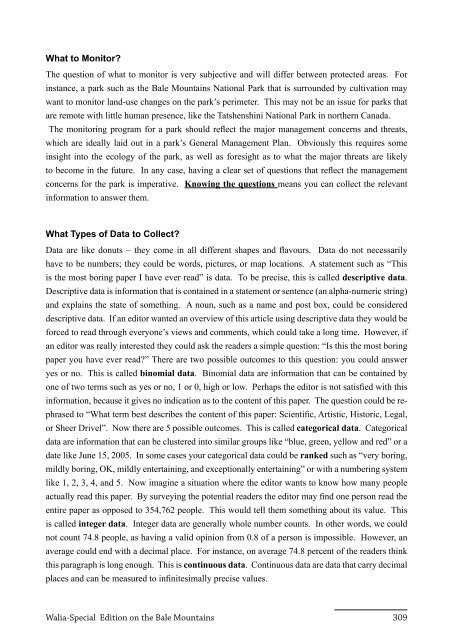Walia Special Edition on the Bale Mountains (2011) - Zoologische ...
Walia Special Edition on the Bale Mountains (2011) - Zoologische ...
Walia Special Edition on the Bale Mountains (2011) - Zoologische ...
Create successful ePaper yourself
Turn your PDF publications into a flip-book with our unique Google optimized e-Paper software.
What to M<strong>on</strong>itor?<br />
The questi<strong>on</strong> of what to m<strong>on</strong>itor is very subjective and will differ between protected areas. For<br />
instance, a park such as <strong>the</strong> <strong>Bale</strong> <strong>Mountains</strong> Nati<strong>on</strong>al Park that is surrounded by cultivati<strong>on</strong> may<br />
want to m<strong>on</strong>itor land-use changes <strong>on</strong> <strong>the</strong> park’s perimeter. This may not be an issue for parks that<br />
are remote with little human presence, like <strong>the</strong> Tatshenshini Nati<strong>on</strong>al Park in nor<strong>the</strong>rn Canada.<br />
The m<strong>on</strong>itoring program for a park should reflect <strong>the</strong> major management c<strong>on</strong>cerns and threats,<br />
which are ideally laid out in a park’s General Management Plan. Obviously this requires some<br />
insight into <strong>the</strong> ecology of <strong>the</strong> park, as well as foresight as to what <strong>the</strong> major threats are likely<br />
to become in <strong>the</strong> future. In any case, having a clear set of questi<strong>on</strong>s that reflect <strong>the</strong> management<br />
c<strong>on</strong>cerns for <strong>the</strong> park is imperative. Knowing <strong>the</strong> questi<strong>on</strong>s means you can collect <strong>the</strong> relevant<br />
informati<strong>on</strong> to answer <strong>the</strong>m.<br />
What Types of Data to Collect?<br />
Data are like d<strong>on</strong>uts – <strong>the</strong>y come in all different shapes and flavours. Data do not necessarily<br />
have to be numbers; <strong>the</strong>y could be words, pictures, or map locati<strong>on</strong>s. A statement such as “This<br />
is <strong>the</strong> most boring paper I have ever read” is data. To be precise, this is called descriptive data.<br />
Descriptive data is informati<strong>on</strong> that is c<strong>on</strong>tained in a statement or sentence (an alpha-numeric string)<br />
and explains <strong>the</strong> state of something. A noun, such as a name and post box, could be c<strong>on</strong>sidered<br />
descriptive data. If an editor wanted an overview of this article using descriptive data <strong>the</strong>y would be<br />
forced to read through every<strong>on</strong>e’s views and comments, which could take a l<strong>on</strong>g time. However, if<br />
an editor was really interested <strong>the</strong>y could ask <strong>the</strong> readers a simple questi<strong>on</strong>: “Is this <strong>the</strong> most boring<br />
paper you have ever read?” There are two possible outcomes to this questi<strong>on</strong>: you could answer<br />
yes or no. This is called binomial data. Binomial data are informati<strong>on</strong> that can be c<strong>on</strong>tained by<br />
<strong>on</strong>e of two terms such as yes or no, 1 or 0, high or low. Perhaps <strong>the</strong> editor is not satisfied with this<br />
informati<strong>on</strong>, because it gives no indicati<strong>on</strong> as to <strong>the</strong> c<strong>on</strong>tent of this paper. The questi<strong>on</strong> could be rephrased<br />
to “What term best describes <strong>the</strong> c<strong>on</strong>tent of this paper: Scientific, Artistic, Historic, Legal,<br />
or Sheer Drivel”. Now <strong>the</strong>re are 5 possible outcomes. This is called categorical data. Categorical<br />
data are informati<strong>on</strong> that can be clustered into similar groups like “blue, green, yellow and red” or a<br />
date like June 15, 2005. In some cases your categorical data could be ranked such as “very boring,<br />
mildly boring, OK, mildly entertaining, and excepti<strong>on</strong>ally entertaining” or with a numbering system<br />
like 1, 2, 3, 4, and 5. Now imagine a situati<strong>on</strong> where <strong>the</strong> editor wants to know how many people<br />
actually read this paper. By surveying <strong>the</strong> potential readers <strong>the</strong> editor may find <strong>on</strong>e pers<strong>on</strong> read <strong>the</strong><br />
entire paper as opposed to 354,762 people. This would tell <strong>the</strong>m something about its value. This<br />
is called integer data. Integer data are generally whole number counts. In o<strong>the</strong>r words, we could<br />
not count 74.8 people, as having a valid opini<strong>on</strong> from 0.8 of a pers<strong>on</strong> is impossible. However, an<br />
average could end with a decimal place. For instance, <strong>on</strong> average 74.8 percent of <strong>the</strong> readers think<br />
this paragraph is l<strong>on</strong>g enough. This is c<strong>on</strong>tinuous data. C<strong>on</strong>tinuous data are data that carry decimal<br />
places and can be measured to infinitesimally precise values.<br />
<str<strong>on</strong>g>Walia</str<strong>on</strong>g>-<str<strong>on</strong>g>Special</str<strong>on</strong>g> <str<strong>on</strong>g>Editi<strong>on</strong></str<strong>on</strong>g> <strong>on</strong> <strong>the</strong> <strong>Bale</strong> <strong>Mountains</strong> 309
















